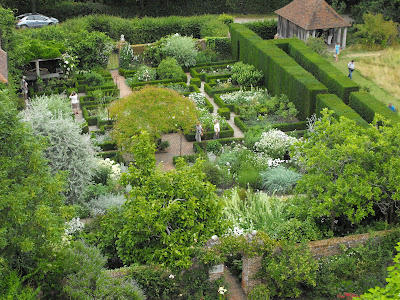Vita Sackville-West was born into a family of considerable wealth and privilege, and thus could afford to buy Sissinghurst, a rather dilapidated Elizabethan "castle." According to her grandson, she used her enormous (obscene?) inheritance to restore and maintain the many appreciable though not in any sense grand buildings on the estate (the grand mansion had long disappeared), and create her garden. (I admit, I am not fair to label it "her" garden, as Harold Nicolson, her husband, did much to plan and create the gardens.) Nearing the end of Vita's life, her wealth depleted, the couple lived off the royalties from their respective publications.
One of the most celebrated gardens at Sissinghurst is the White Garden; one feels compelled out of respect to capitalize its very name. Having experienced it, having witnessed others' reactions, having felt its ethereal character, I can testify to why that is so. The White Garden floats on air; indeed, the White Garden may be the experience of air itself.
Where the physical body imposes limitations on our experience of life, the mind compensates through thought or imagination. The experience of air--of living in and with air--may be felt while riding a bike (not as a sport, but as an enjoyment, a leisurely recreation when we have abandoned all pretense and stress and surrendered to the activity itself and allow ourselves to experience the sensations of the moment). But I have discovered another experience of air--one much less obvious, one less palpable. And that is The White Garden at Sissinghurst.
Most attention focuses on the plants and design, right so. But my first inclination was to look directly at the center of the White Garden under the rose portal, on which a few flowers of Rose Mulliganii remained (purely for my benefit, I am sure!). There stands one of the few surviving Vita and Harold relics: a 17th century Chinese oil or ginger jar which Harold purchased while on diplomatic assignment in Cairo. That set a necessary tone for me: it grounded me as I began to float in the space that is the White Garden.

The design is ingenious. While it looks quite geometrical, nothing but the boxwood hedges, low to the ground, is square.
Inside each "hedge box" exists a veritable phantasmagoria. The effect is simultaneously uplifting and soothing; if the singular white specimen soothes, the eye soon catches an array of whites and silvers, one's field of vision extends, and one floats above, living on air itself.
The entire experience--not simply the White Garden, but the whole of it--proved incandescent and thus indescribable. I look back at my journal entries and photos, and cannot quite articulate that which I felt, that which I experienced, and that which I came to think and remember. This seems to me the mark of an expert garden: to leave the visitor with a sense of awe and a sense of aspiration, enveloped in the ineffable singularity of the self and the garden.
.








No comments:
Post a Comment